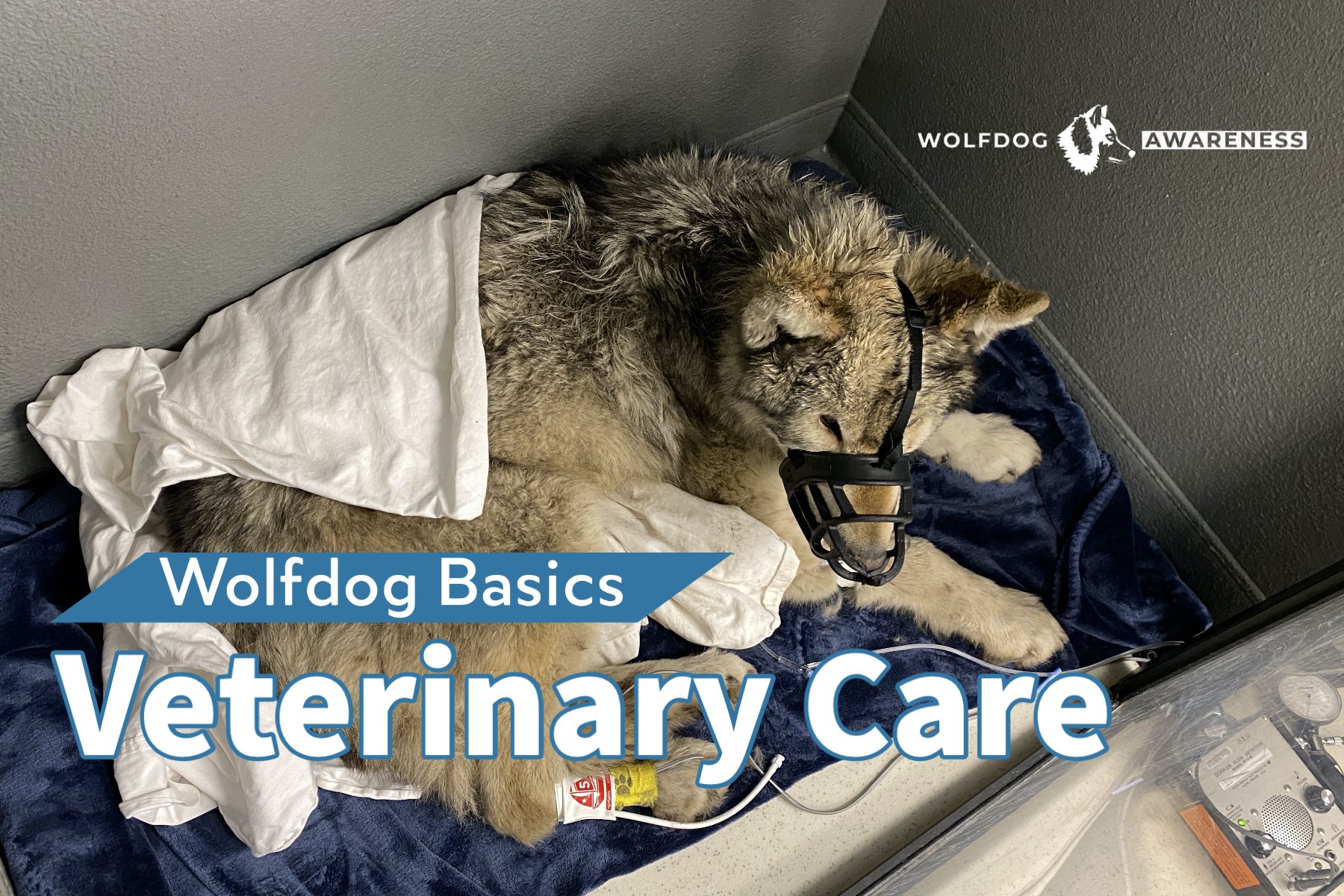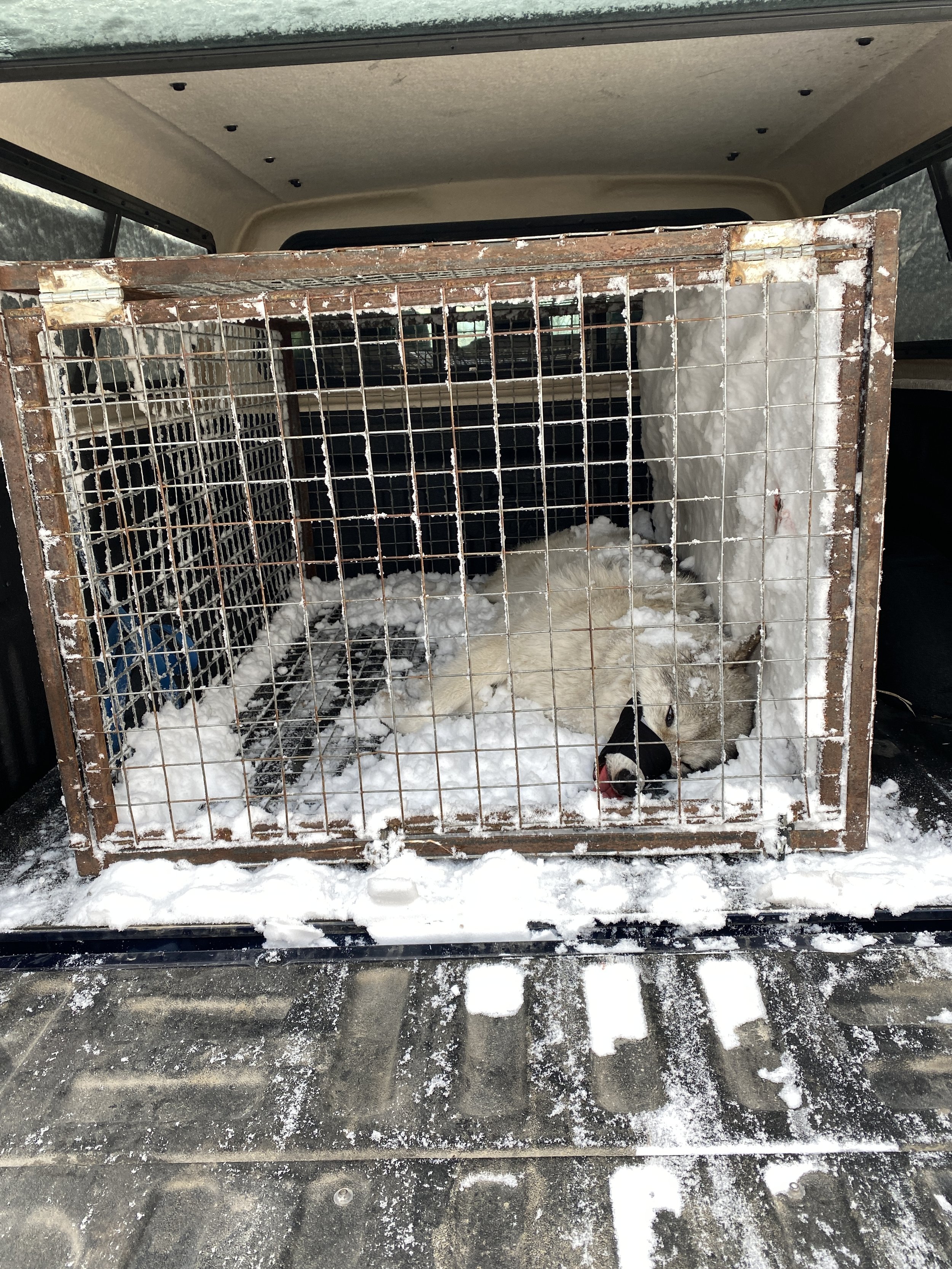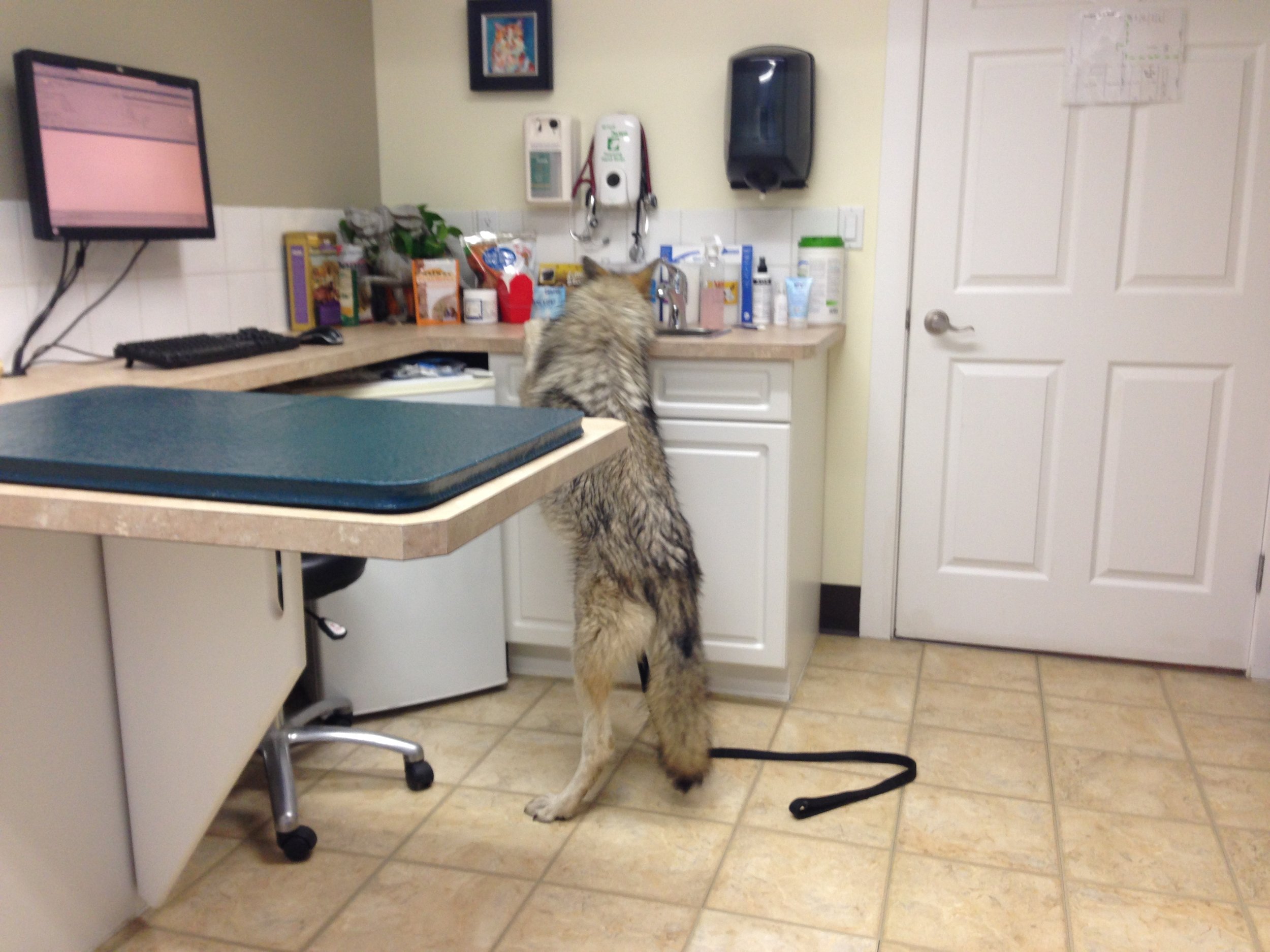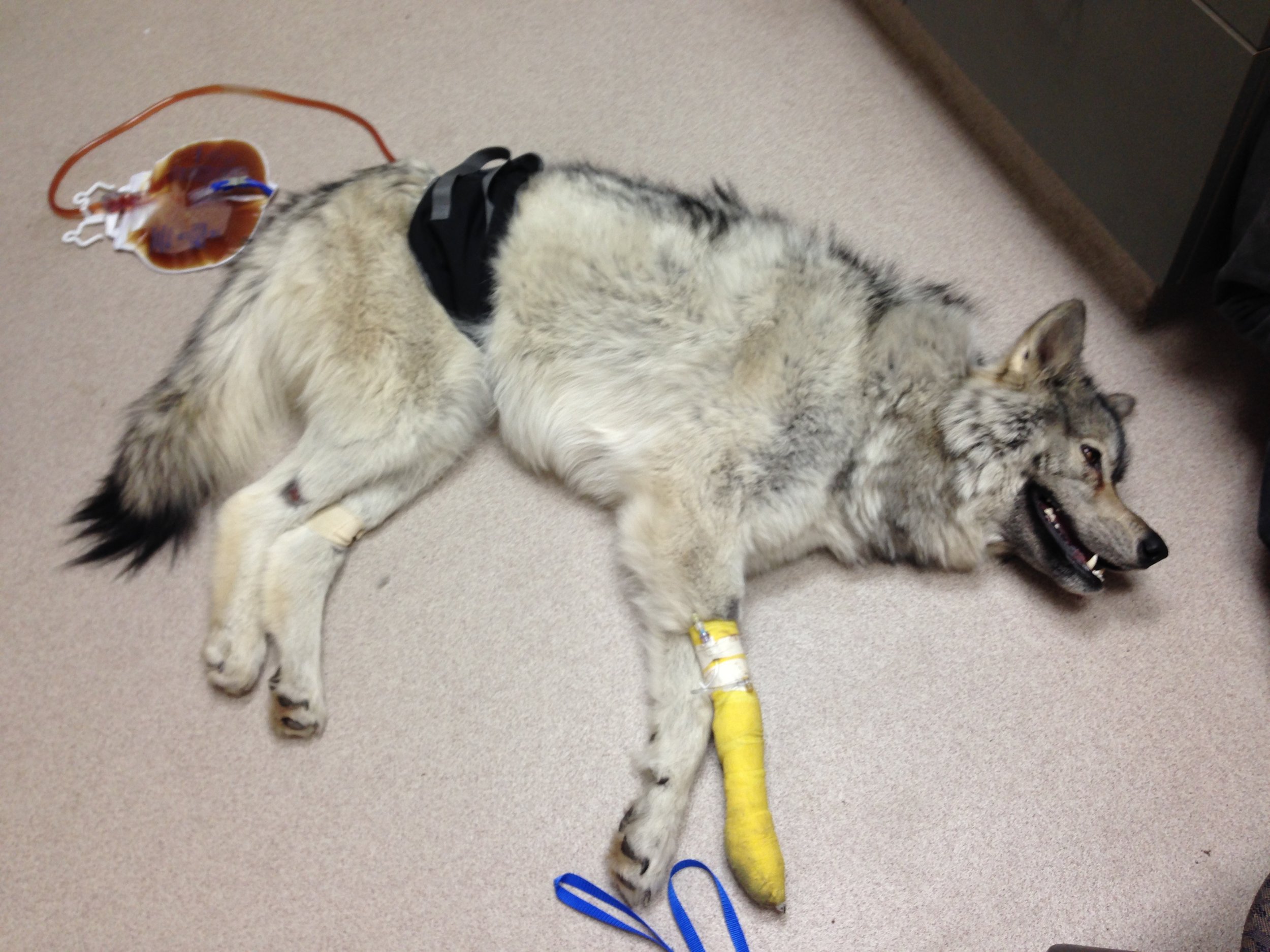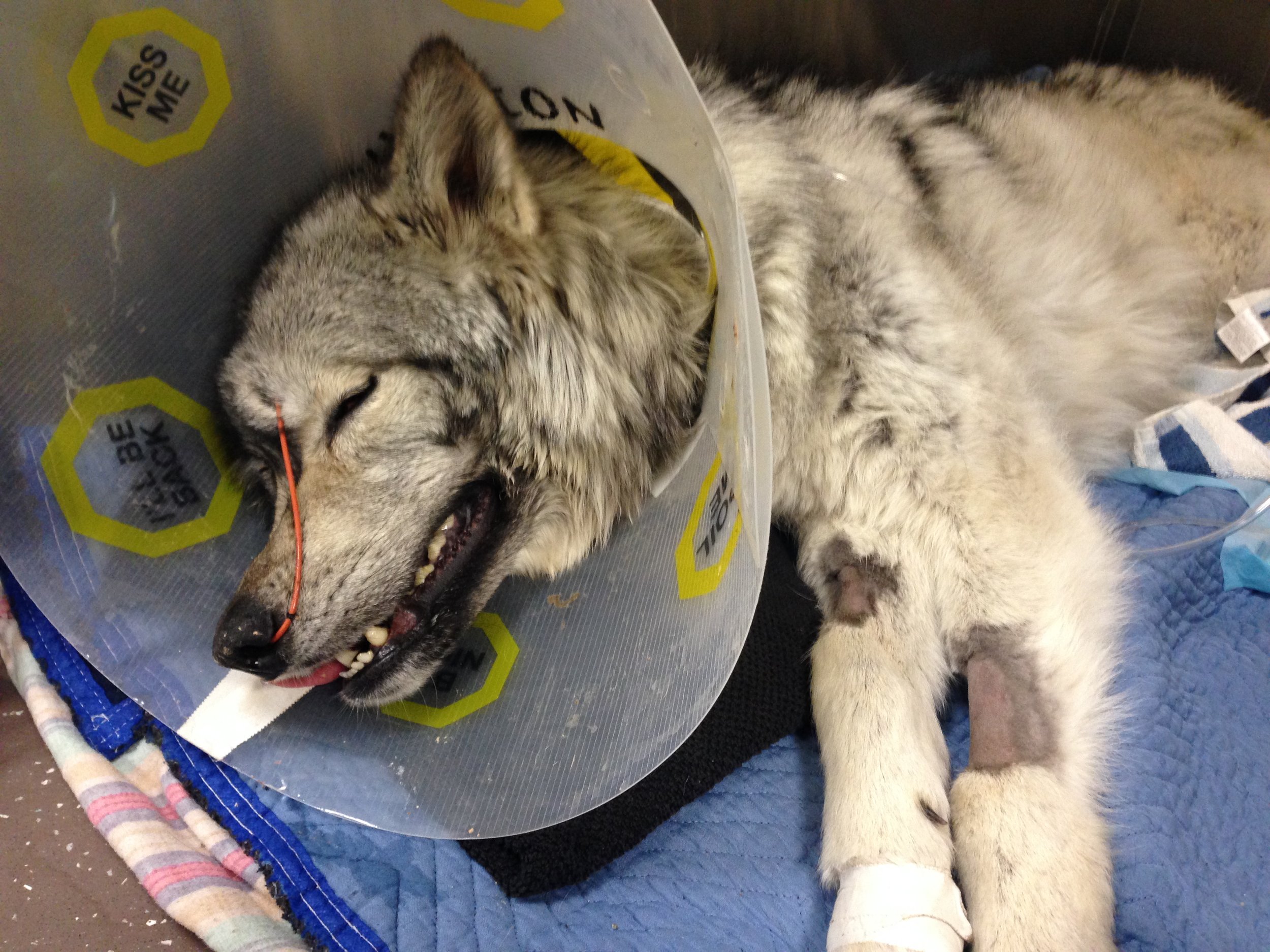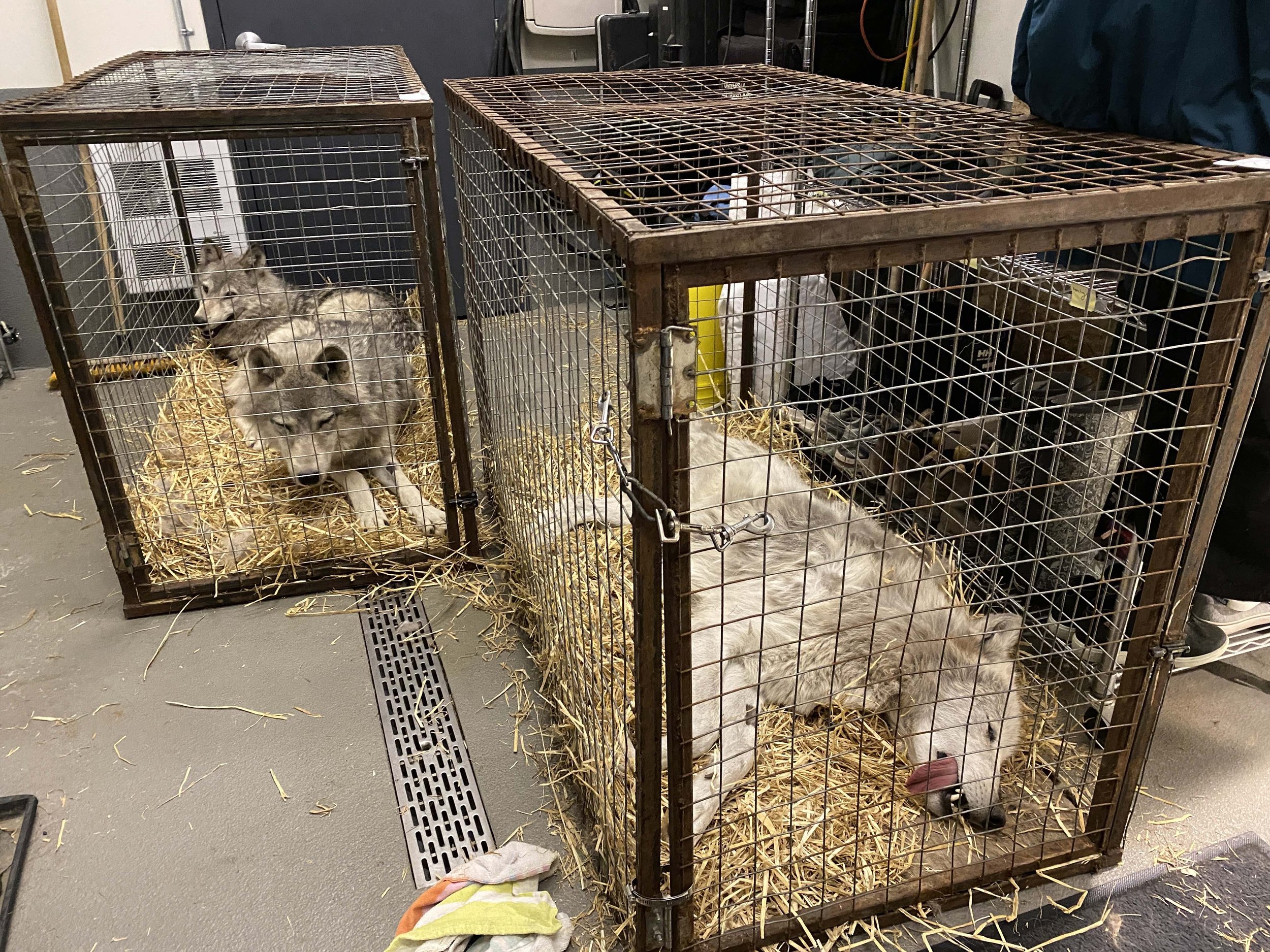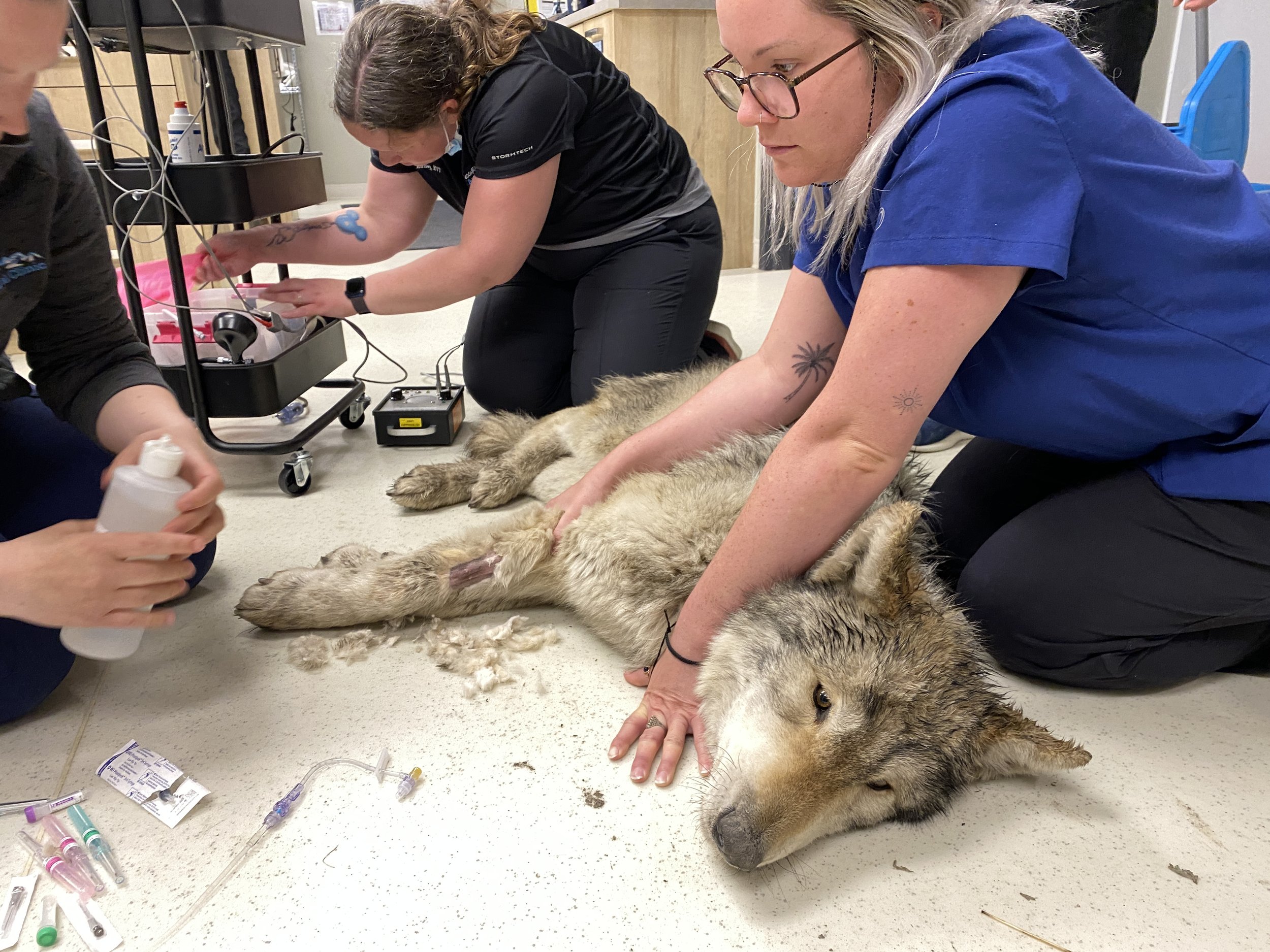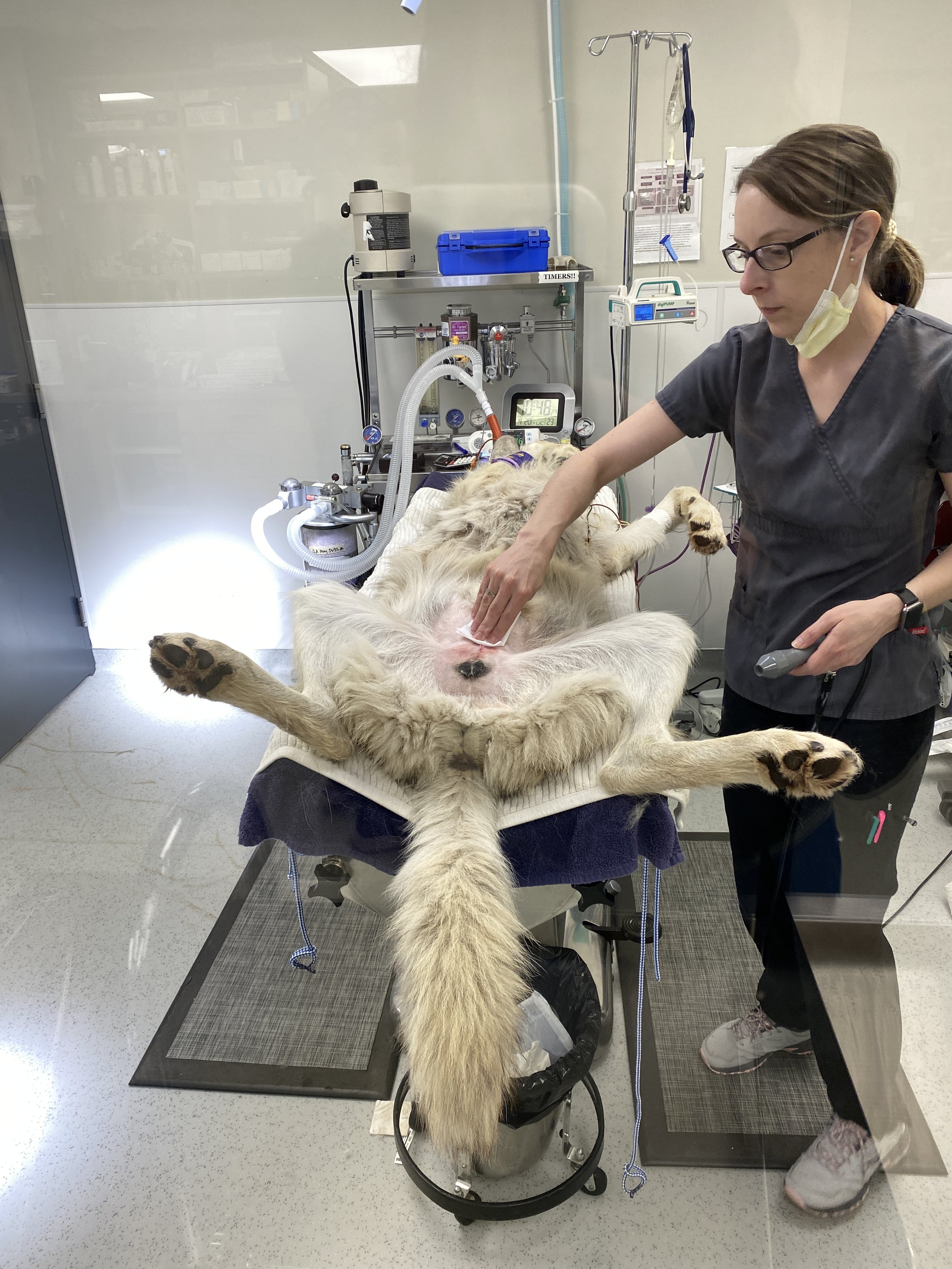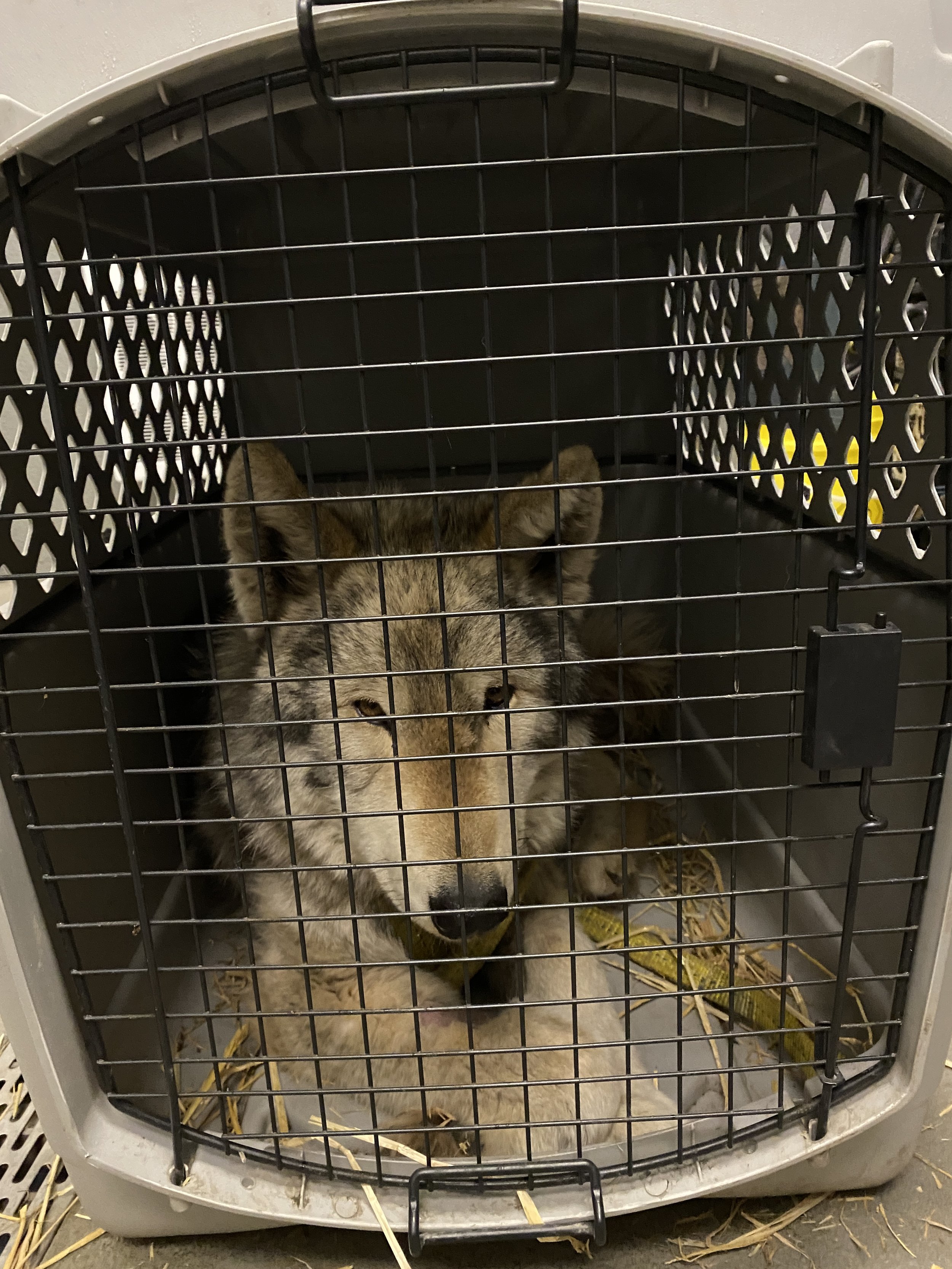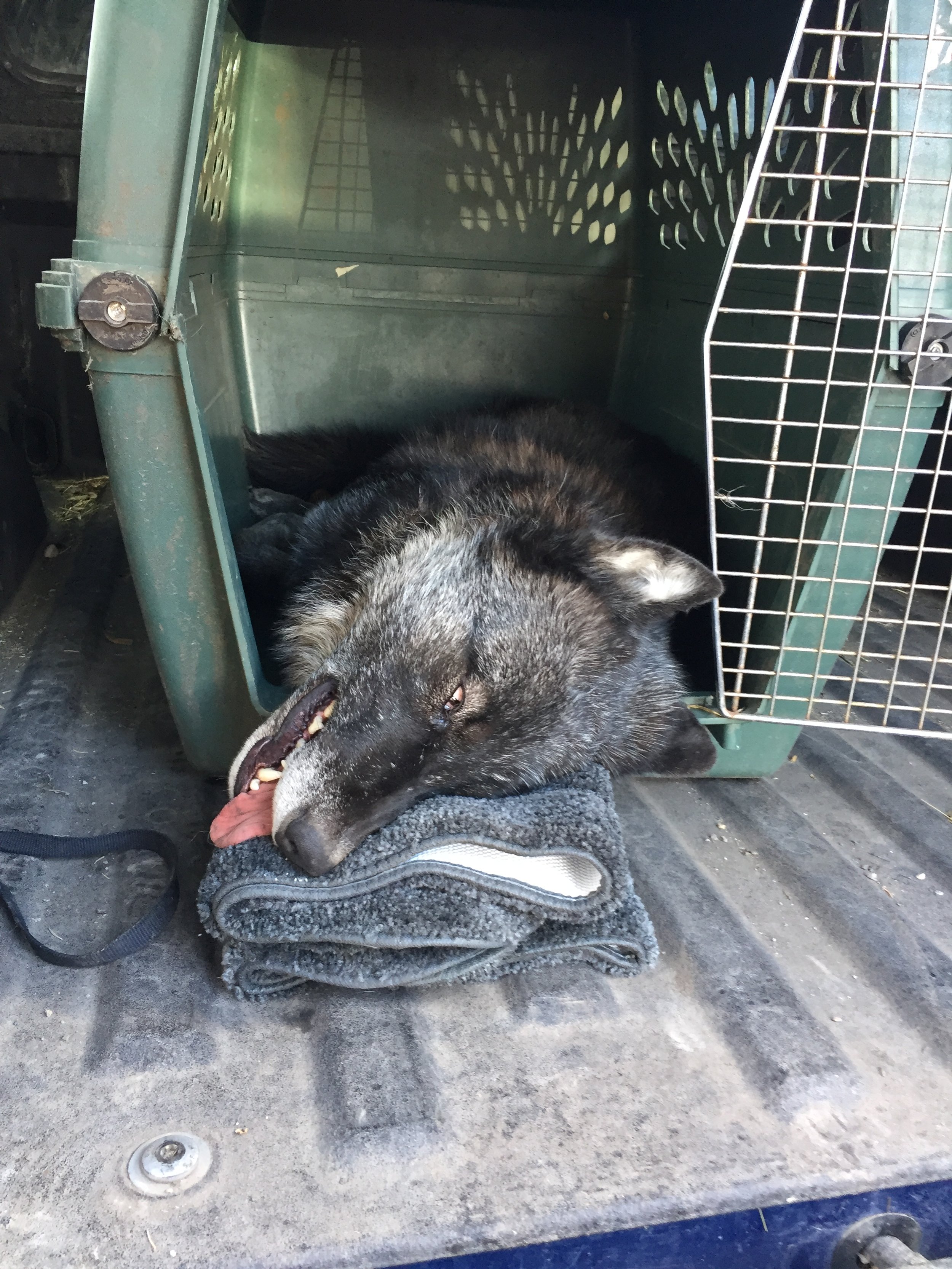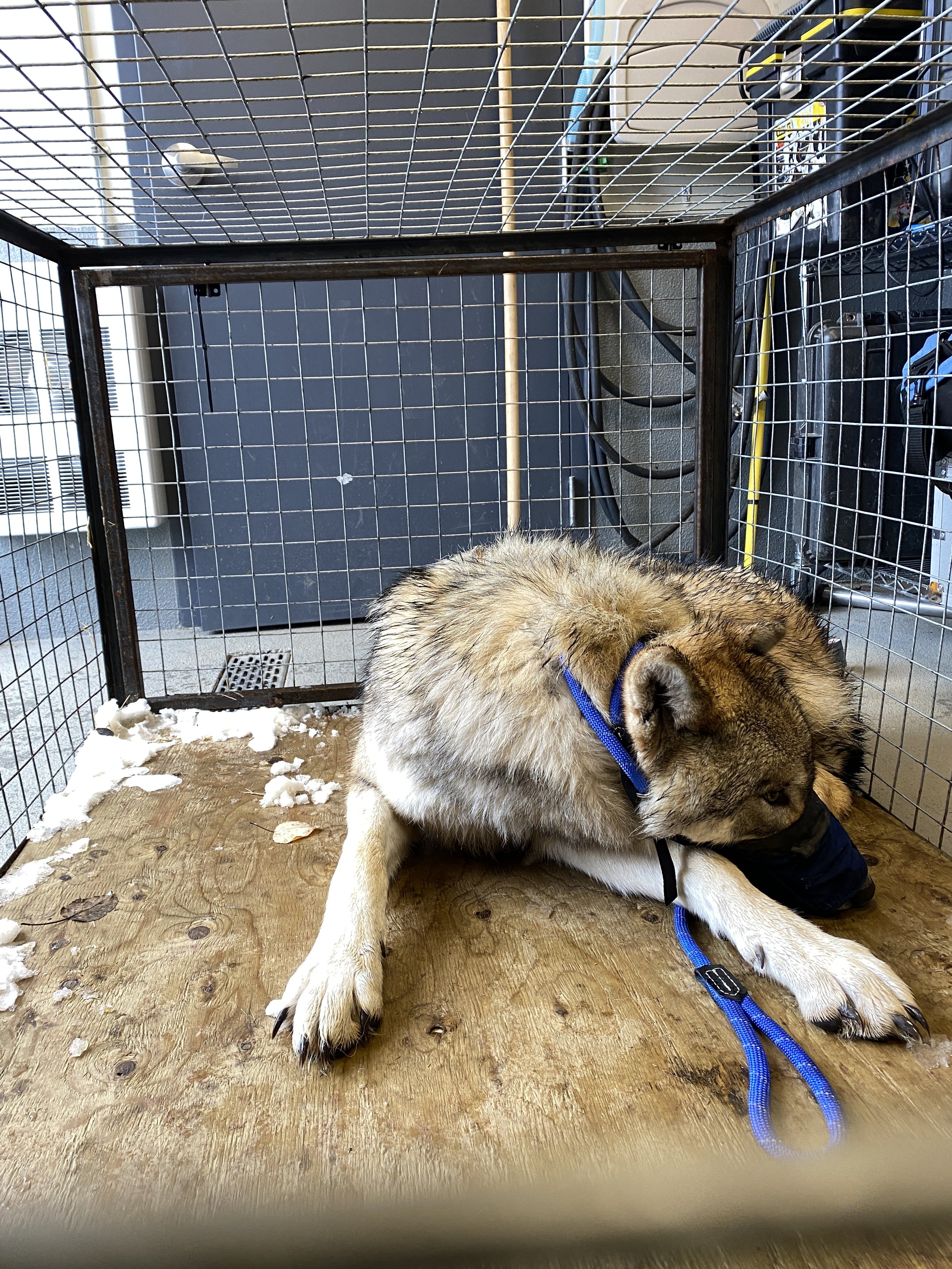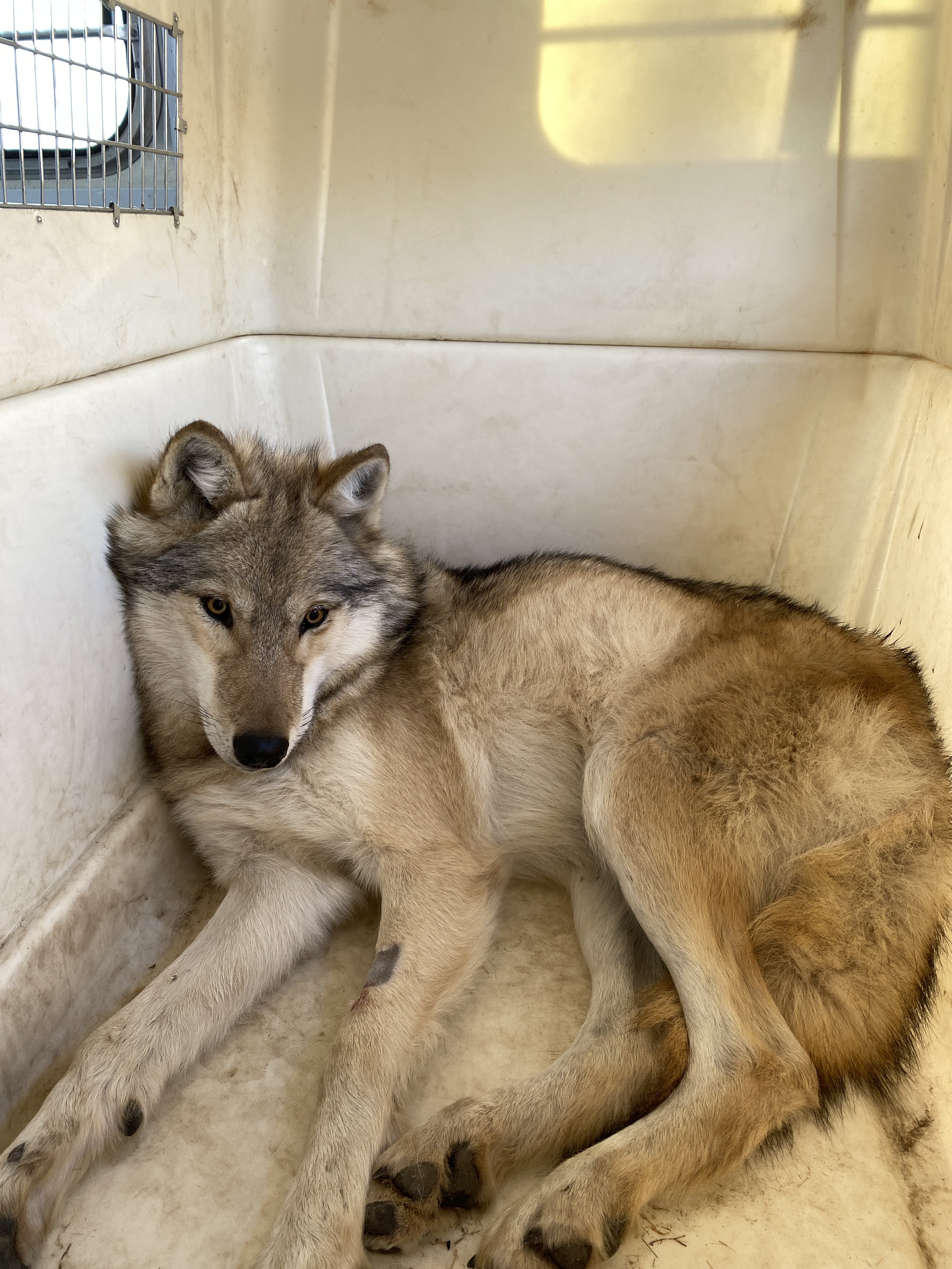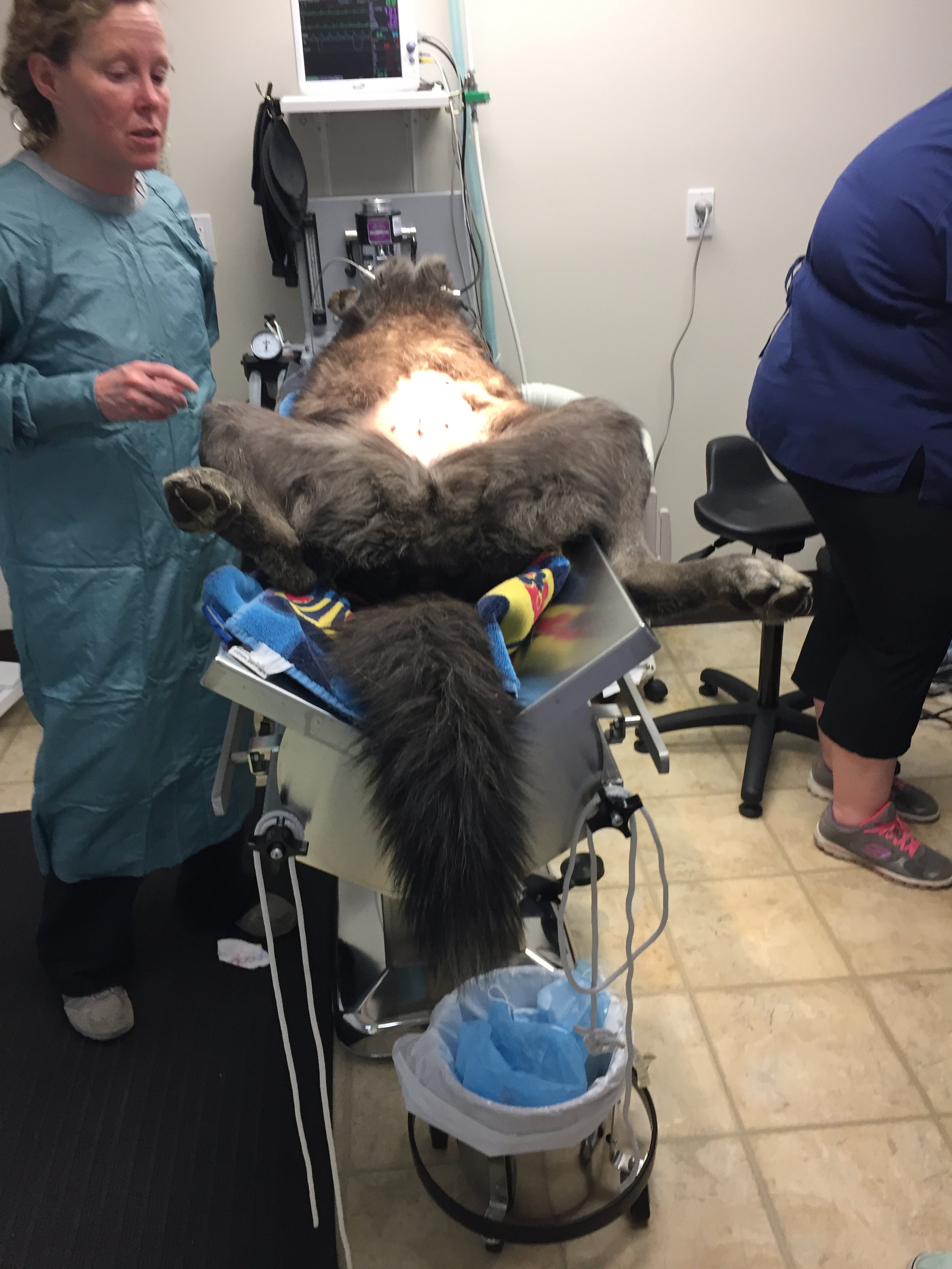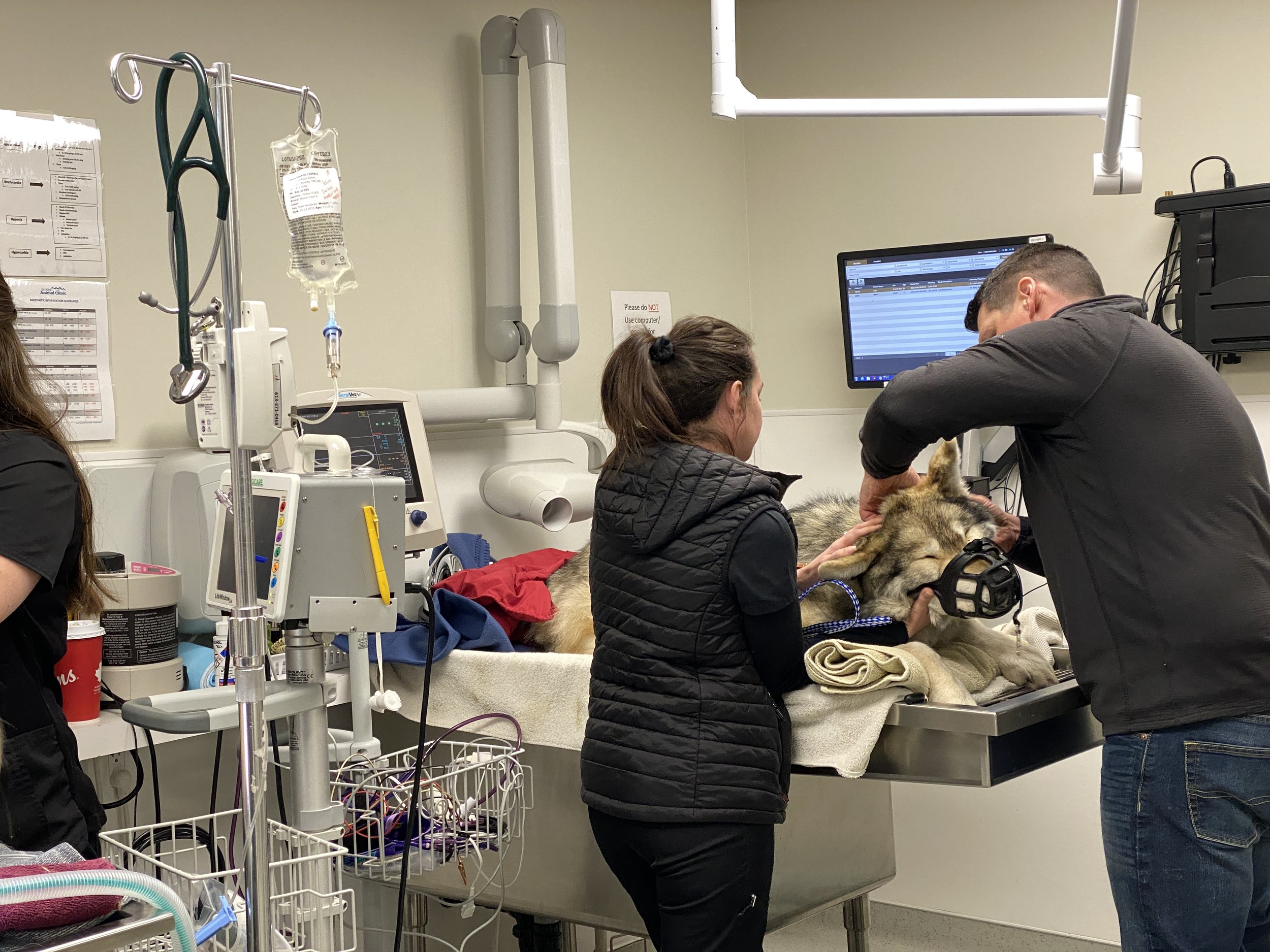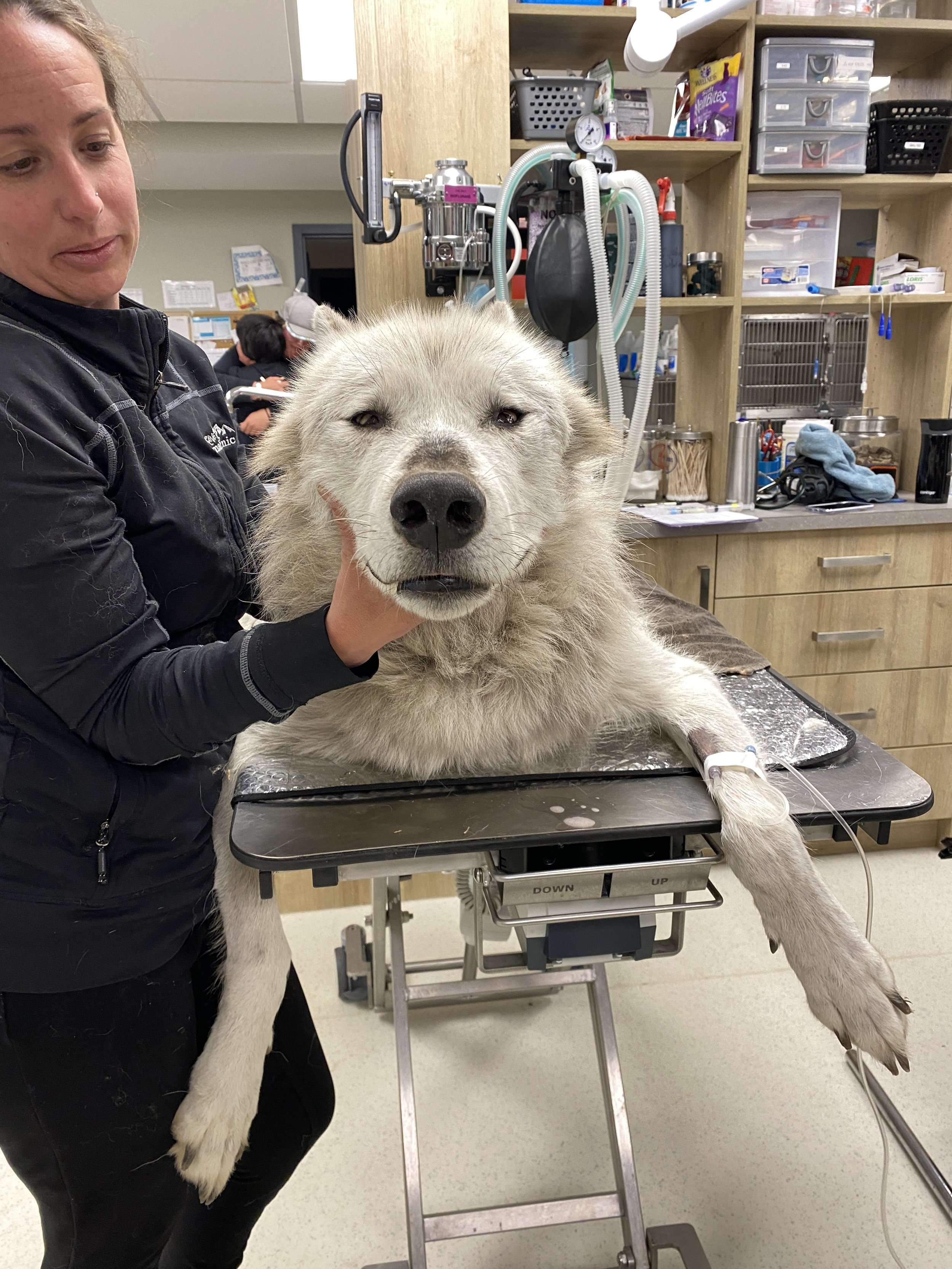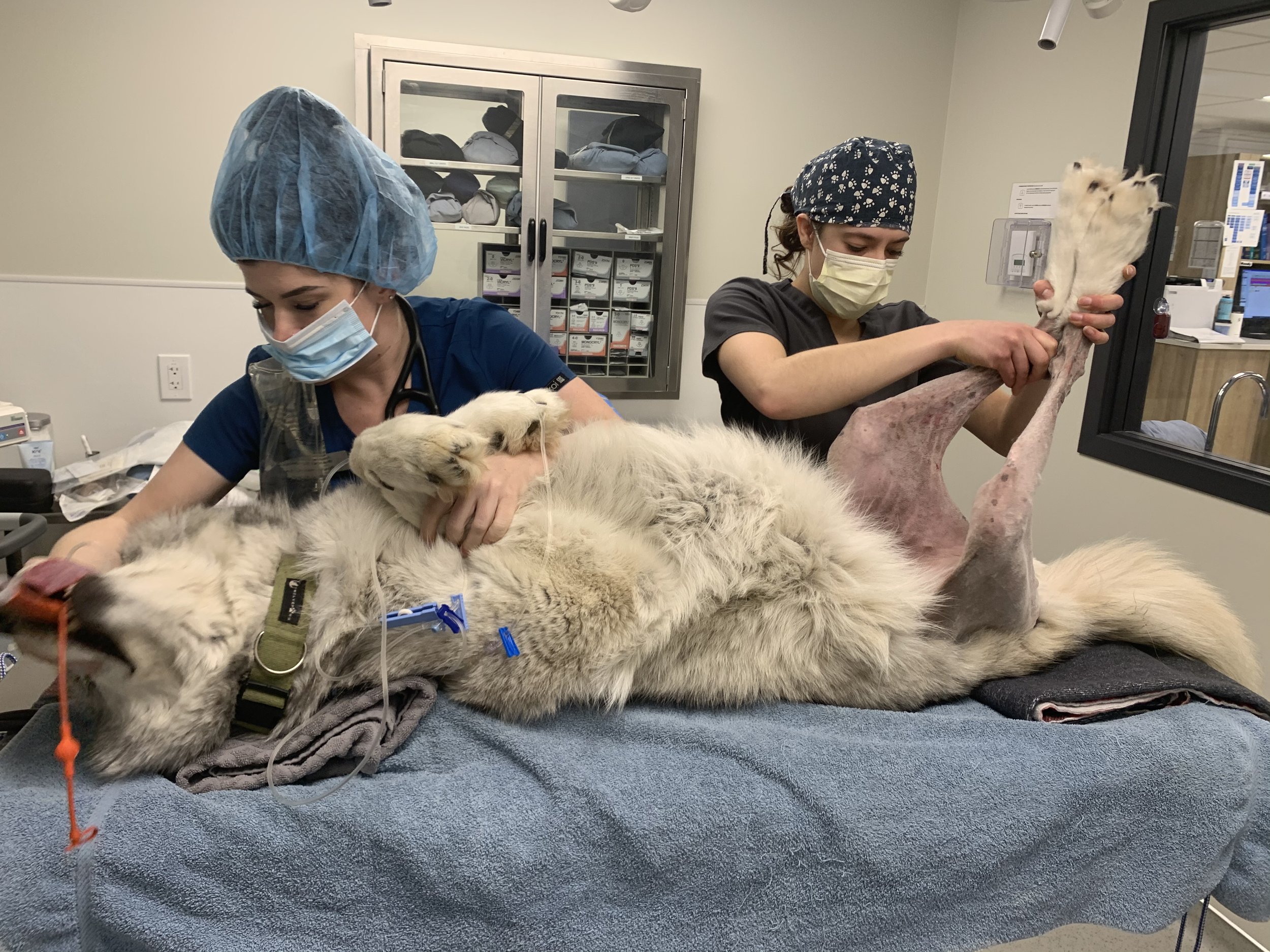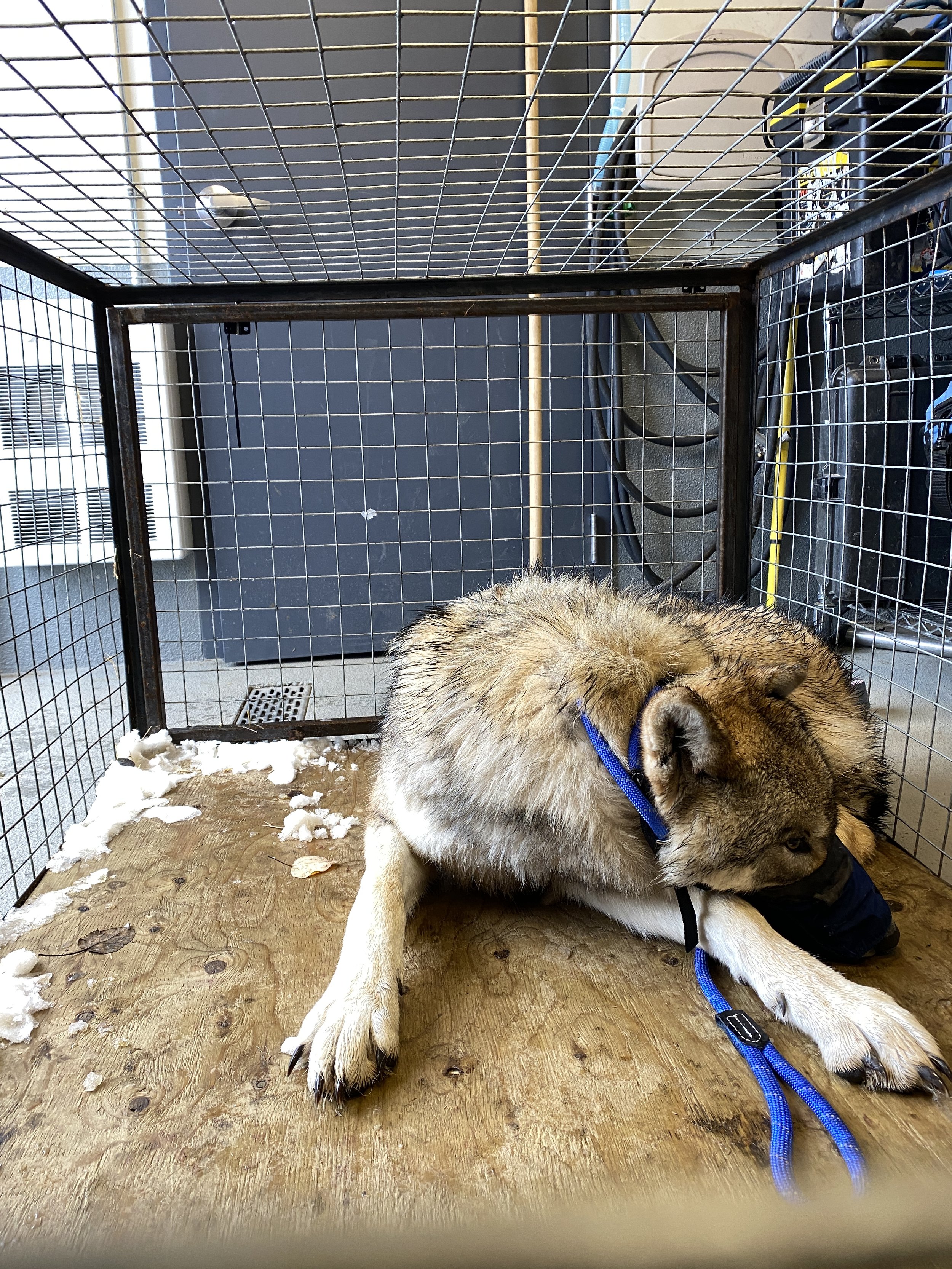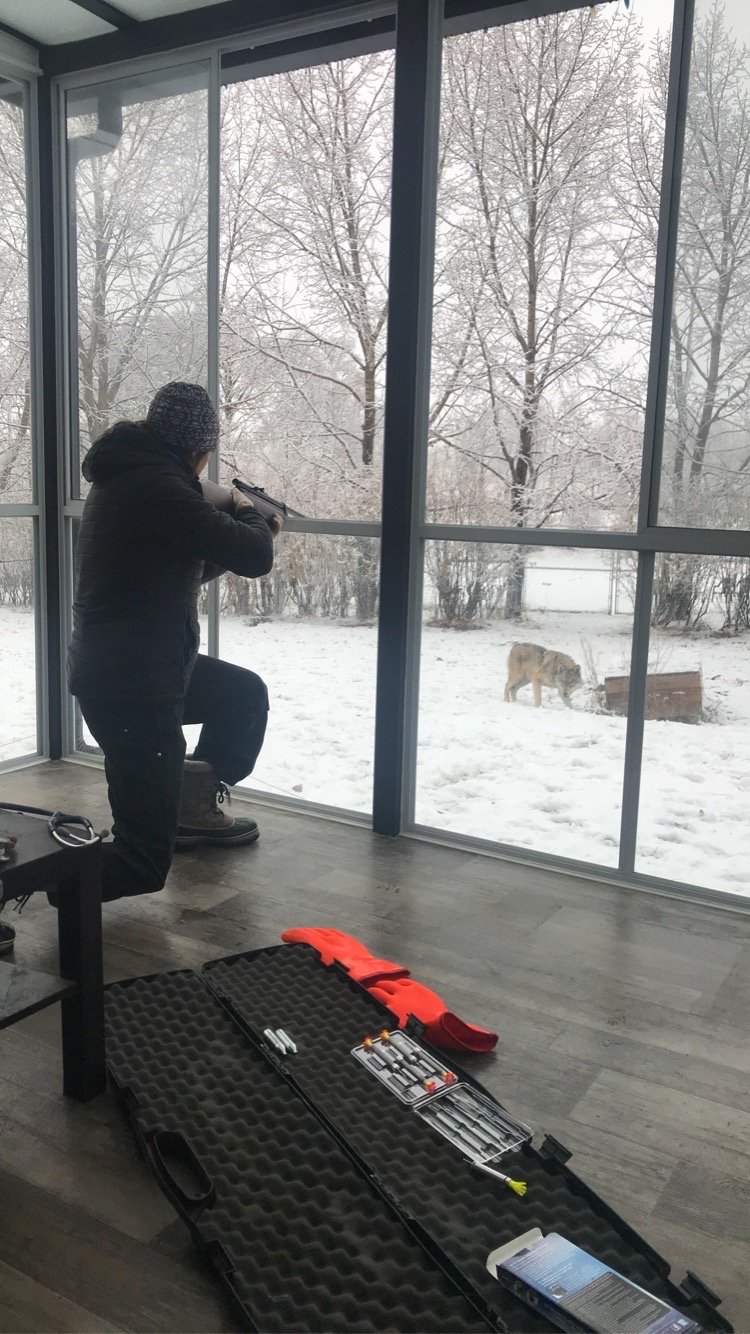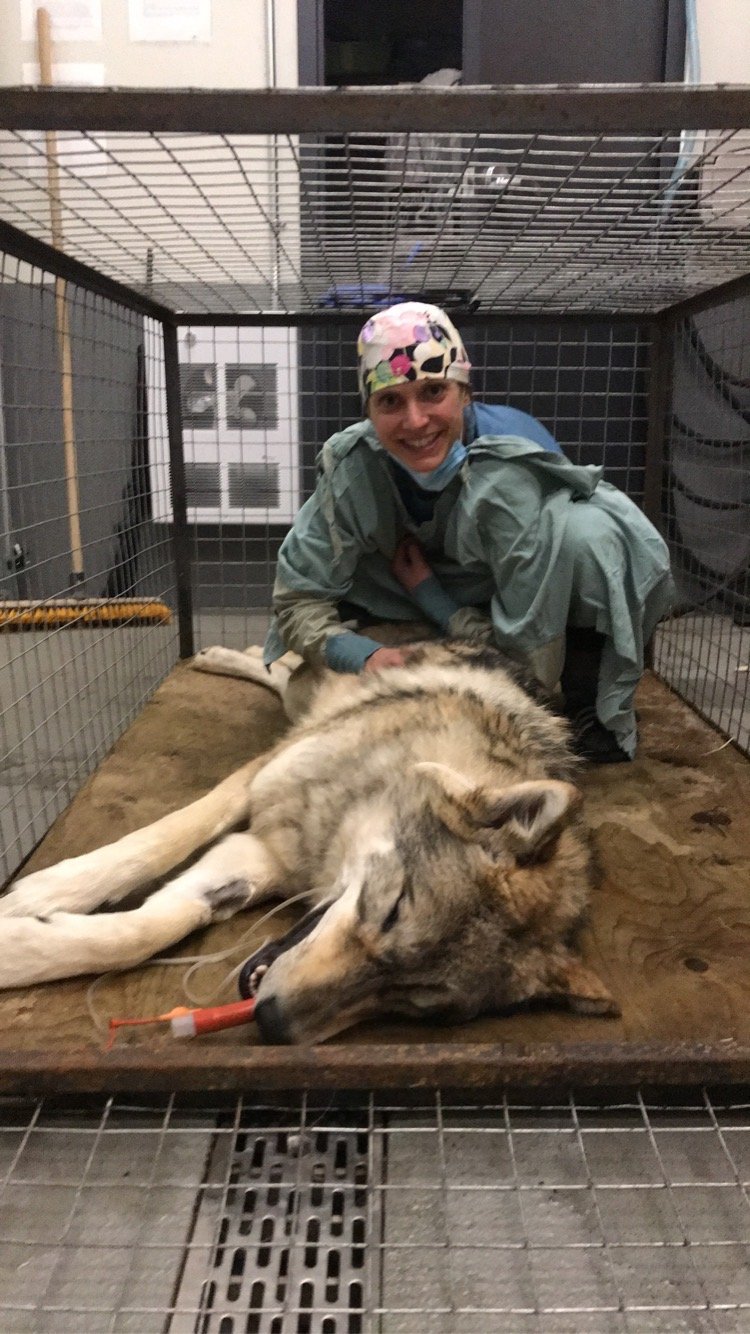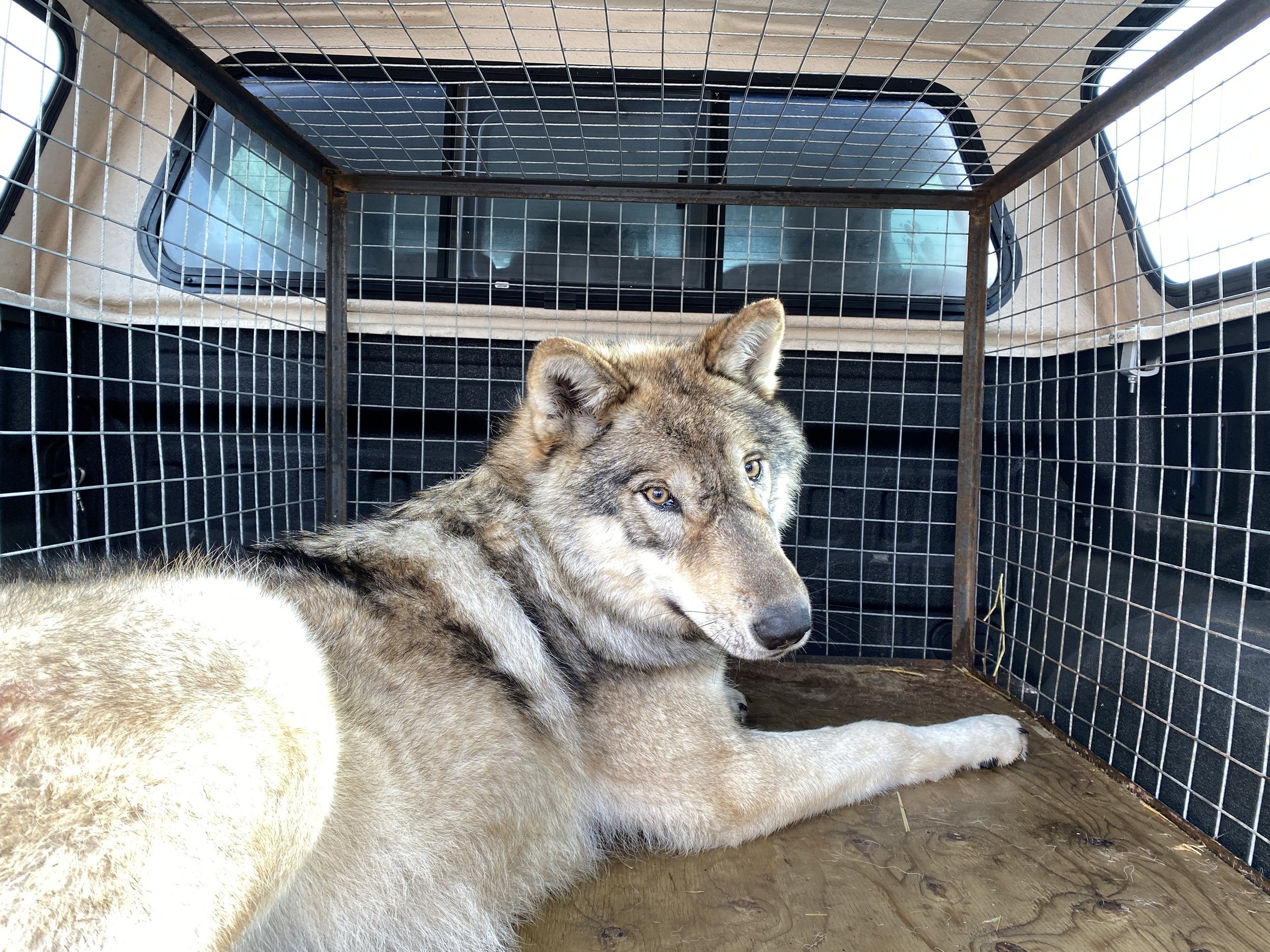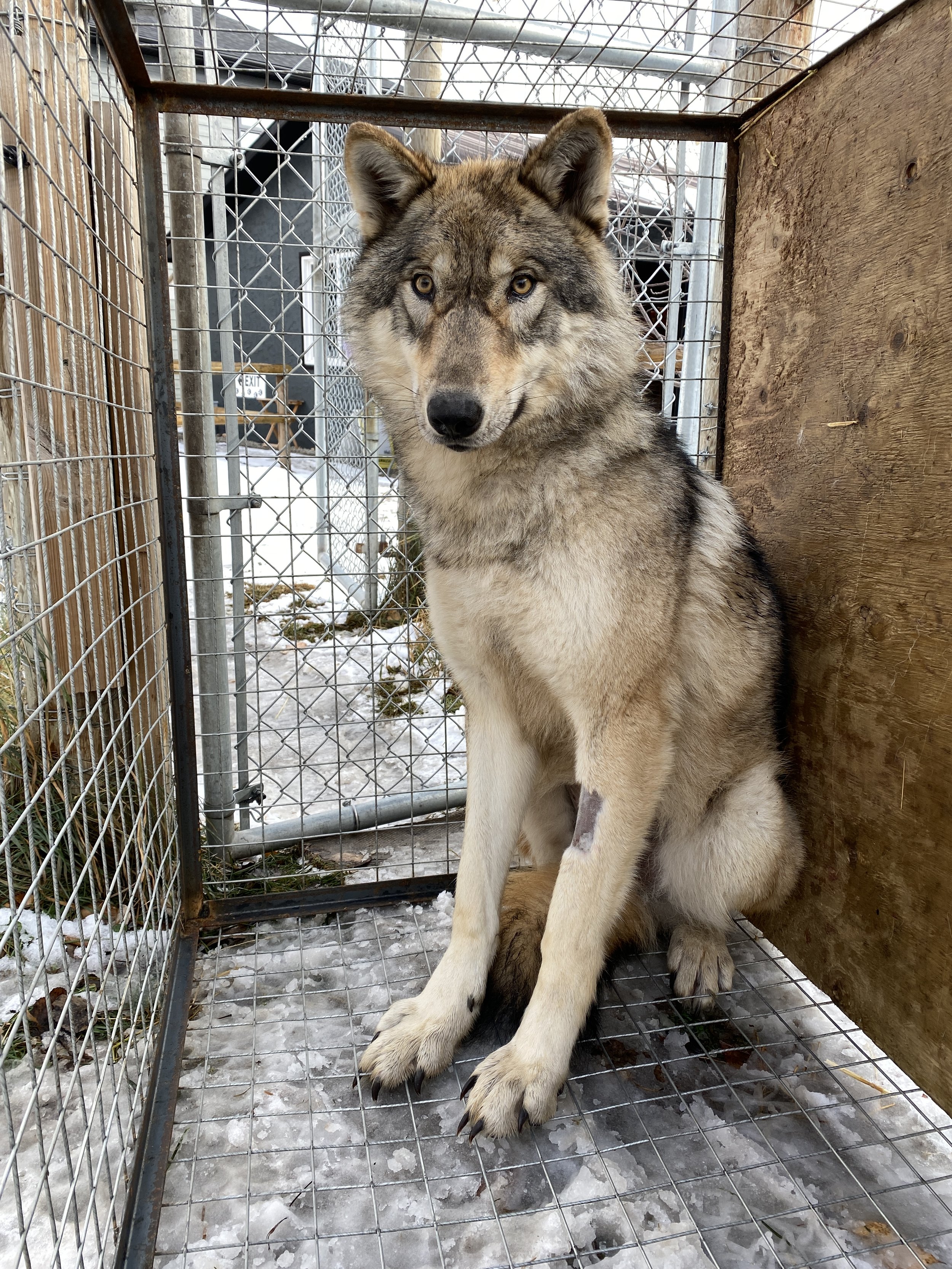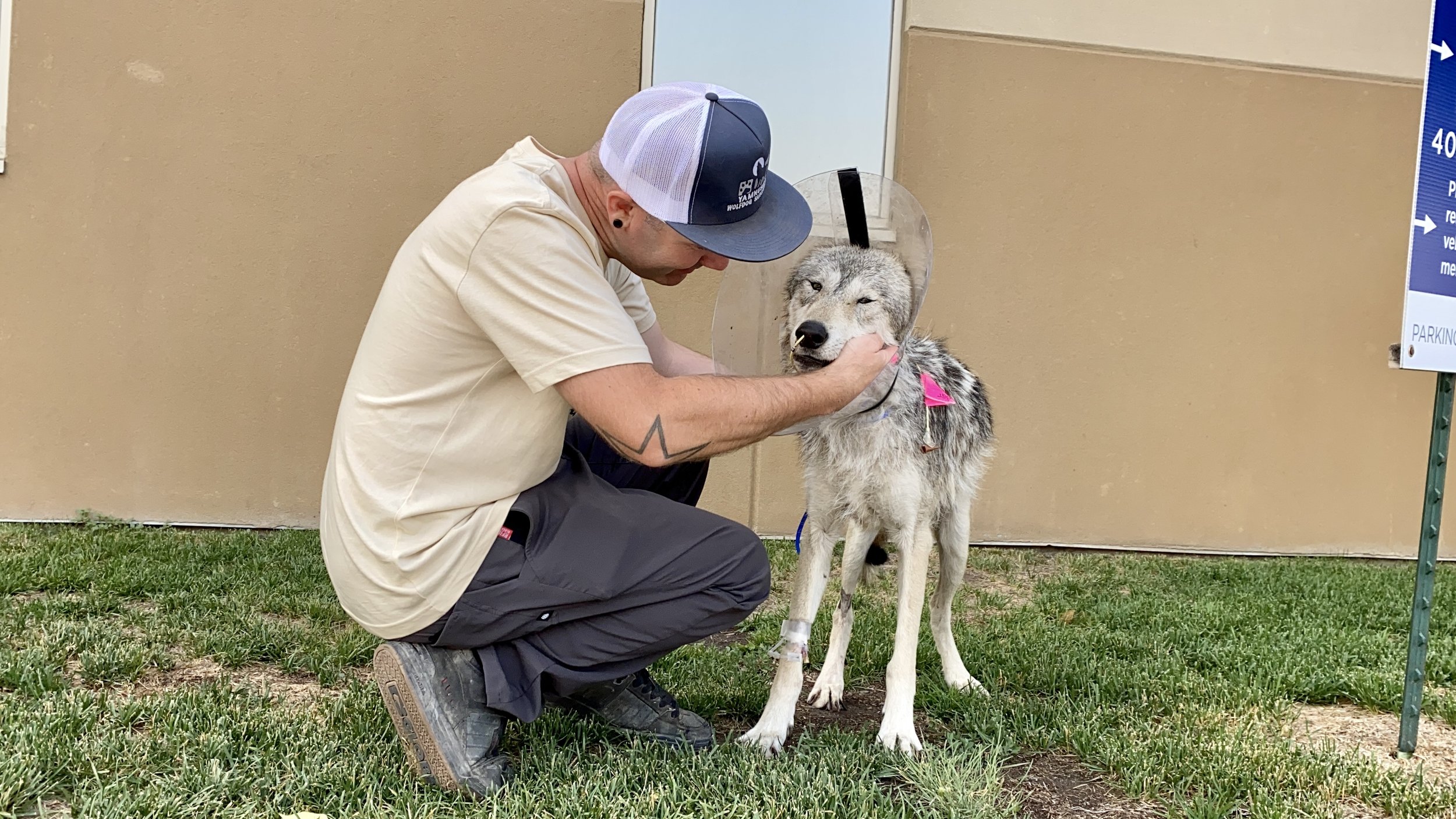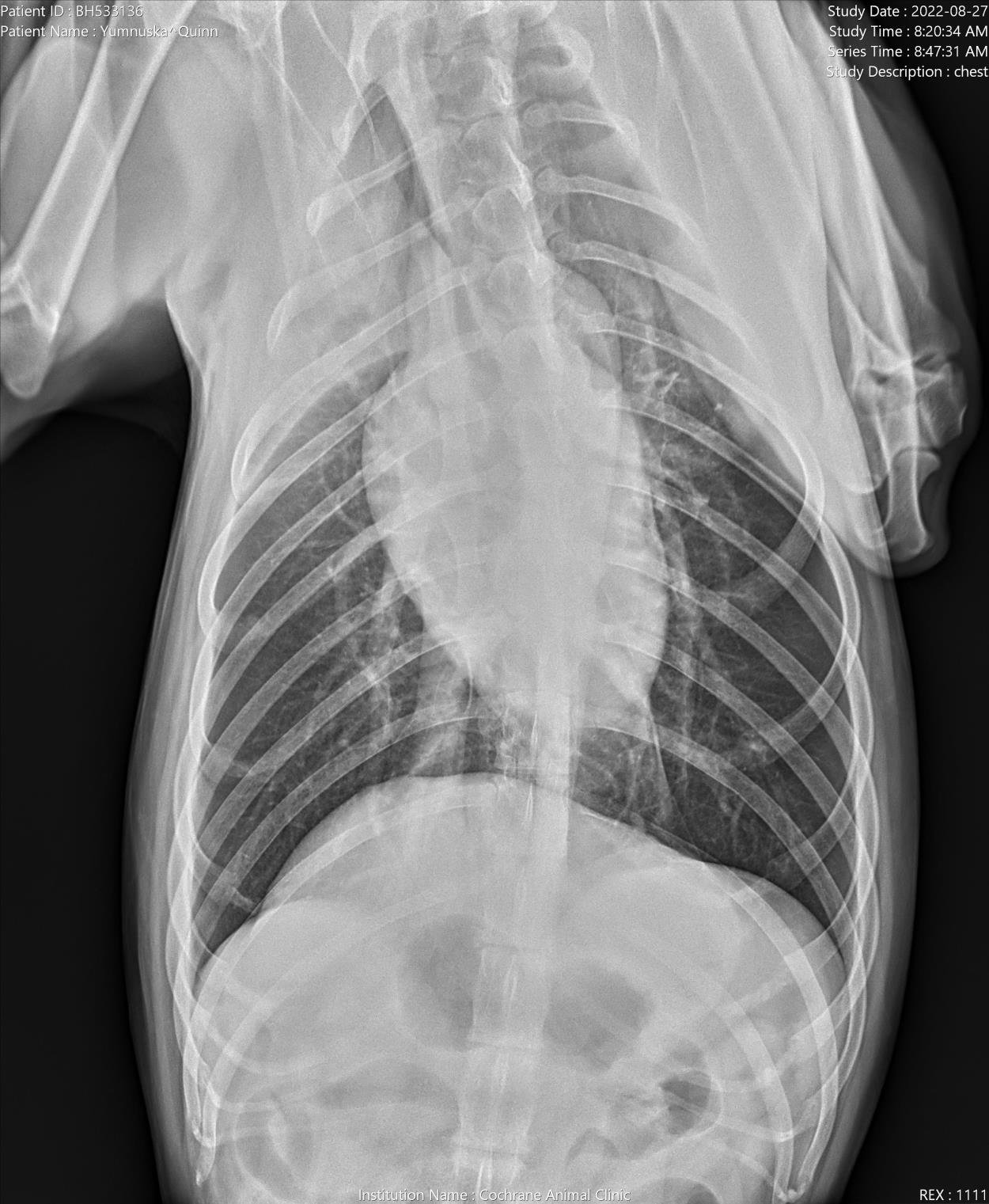Veterinary Care
Veterinary care for wolfdogs can be a tricky thing depending on your wolfdog. Like always the degree of challenge you may face will be so incredibly dependent on your individual wolfdogs based on their content level as well as their socialization level. Some of this may not apply to you and your wolfdog at all, while some of it you may incredibly relate to.
Depending on how comfortable your wolfdog is with new people, new places, and strange things happening will largely dictate how simple or complicated veterinary care can be. We have some wolfdogs where veterinary care looks pretty similar to that of a domestic dog, while there are others that look more like dealing with wildlife. There is a huge spectrum here, so please take what is useful from this article and ignore what is not. If you are a prospective wolfdog owner, take all this information to heart as you never know what “type” of wolfdog you will get and if you are one of the ‘unlucky’ ones where vet care is a real challenge, you will at least have been warned!
One of the keys to success with veterinary care for your wolfdog is finding the right vet! Not all vets have the same experience dealing with the sensitivities of wolfdogs and it is really important to find a vet that is not only able to really understand the body language and behaviour of your wolfdog but also someone who is willing to adjust their normal practices to suit your wolfdog. Many vets may not understand the additional limitations that can come into play when we are dealing with fearful wolfdogs and the reactions that may present due to this innate fear response. If you have a wolfdog puppy that you are in the process of socializing, having a good vet is paramount! This is the time your puppy will make up its mind about what it will deem as scary and what isn’t, so having really positive experiences from the beginning is very important and helps set you and your pup up for success in the future.
Below I will discuss some of the typical challenges we go through when it comes to vetting our wolfdogs at the Sanctuary, and just for fun I will share some of the extremes we see as well.
Aspen at the vet after he ingested a foreign body and required emergency surgery to remove what turned out to be the knot of a rope toy. Yes, even wolfdogs are silly enough to swallow dog toys!
In order to provide vet care for the wolfdogs, one of the critical pieces of the puzzle is transport. For some wolfdogs that may pose a big challenge. Some of the ‘easier’ wolfdogs are able to be loaded up in the cab of our truck, but it still usually requires two people. A driver and a wolfdog handler! Some wolfdogs will start to get uncomfortable once the vehicle is moving and therefore start scratching at the windows, or trying to get onto the centre console, or worse, poop all over the backseat. The wolfdog handler (which is always me!) has to provide lots of positive distractions such as ear rubs, gentle words of encouragement and many distractions to ensure the truck does not suffer too much damage. The wolfdogs that do not readily load up into the cab are usually crated and transported in the covered box of the truck. Depending on the wolfdog and how they do in a crate, this might mean that the wolfdog handler (aka me) is riding to town in the box of the truck to ensure nothing goes awry during the drive. Then lastly, for the wolfdogs that we have no hope at all of ever catching and crating, we are very fortunate to have a vet that is experienced with a tranquilizer gun. This can still be tricky as the wolfdog has to come within 10ft of the gun and has to hold still long enough for the vet to get a clean shot. For a wolfdog that is scared and knows something strange is happening, that is not easy and we have had to get extremely creative in the past to make this happen. I hope for your sake, you have a wolfdog that can be transported without too much trouble as that is a big piece of the puzzle.
Now we’re at the vet clinic, but now comes the part where the vet (someone who your wolfdog has not built much trust or respect with) has to examine your wolfdog. For the wolfdogs that don’t have much fear of humans, this may be as simple as you being there for your wolfdog and they will allow the examination/procedures to happen. For other wolfdogs, this may require being sedated in order for the vet to be able to do their job. Many of the wolfdogs at the Sanctuary require sedation in order to be vetted properly. I will note that this is injectable sedation. Oral sedatives such as trazadone for example are not effective for a wolfdog that is displaying a HIGH degree of fear or reactivity. The adrenaline generated from their fear response will easily override any oral sedative your vet would prescribe for a typical dog. Do not bank on oral sedatives helping much or at all for this type of fearful wolfdog. We have experimented with many oral sedatives and truly nothing has ever actually properly sedated a fearful and reactive wolfdog. If you have a very fearful wolfdog that may pose a bite risk, one thing we often do is when the animal is still crated, tilt the crate and have the vet inject the wolfdog through the crate (a strong wire crate where you have lots of access is important). The wolfdog will then nicely fall asleep in their crate and the rest is easy. When the vet appointment is finished, it can also be helpful to give the reversal of the sedation in the crate so they have a safe space to recover in and be transported back home. Again, if you have a wolfdog that isn’t overly fearful of people or isn’t a risk of snapping or fear biting, ignore all this talk of sedation, it isn’t necessary in those cases. This merely touches on some of the experiences I have had with wolfdogs at the vet. Every wolfdog and every situation is different and it is up to you, the owner, to know what is right for your wolfdog.
Depending what your wolfdog was in for, your next challenge might be meds. Some wolfdogs are easy to administer meds to, and others are not. I will discuss some of our tricks of the trade for those difficult ones when it comes to oral versus topical, and pills versus liquids.
-
Generally I try to avoid liquids as those are usually the hardest to get into the wolfdogs. It’s not like you can easily spray it into their mouths. That might work once, but once the wolfdogs know, good luck ever doing it successfully a second time. Liquids tend to spill and are hard to disguise as they blend into whatever food you put them in. Usually as long as it’s a fairly small volume of liquid, I have a trick where I put it on some frozen meat so it kinds of solidifies onto the food. Read more about this below about my experience with giving Meloxicam.
-
Pills can be tricky or be easy, depending on their smell and how much your wolfdog inhales food or not. The standard ‘pill inside a meatball’ trick is my go-to. If that doesn’t do the trick, I pull out the stinky stuff like canned food, beef tripe, bacon, fish skin, etc. You may need to cut the pill into smaller bits to make it easier to disguise. Find out what things your wolfdog absolutely loves and what might disguise the smell and taste of the pill.
-
These are the hardest for most of our wolfdogs! If you walk up to your wolfdog with a glob of something on your finger, they will either want to eat it or will smell it and avoid you like the plague. So again, use food and interesting smells as a distraction. This can sometimes be a two-person job!
Below I will go over some of the typical medications we have to administer to wolfdogs and how we go about it:
-
-For the wolfdogs that love food and are easy to get food into, putting a dewormer pill into a meatball is best. As of writing this article we use Interceptor Plus as our oral dewormer of choice.
-For the wolfdogs that are very difficult to get oral meds into, but ones we can touch, we use a topical dewormer. You can often disguise it in a good petting session and sneak those drops onto their skin during a good back rub!
-
-For the wolfdogs that we can get oral meds into, we do the standard meatballs.
-For wolfdogs that are tricky to get oral meds into but must get a course of antibiotics, there is a long acting injectable option. It is pretty expensive, but if you have a wolfdog that you know will be impossible to get pills into and are already at the vet sedated, the injectable version is easy and can be a real stress saver!
-
Metacam (meloxicam) is a common liquid medication we have to use. Since they need to get a very specific dose to be effective we have to make sure they ingest their exact dose, and since liquid has a tendency to spill all over, this can be tricky. The easiest thing I have found is to take some very frozen raw food and put the liquid on that. It will sort of freeze to the meat, so as long as your wolfdog eats all of the food bits, they will ingest the whole dose.
A fun little demonstration on how I get Quinn to eat her antibiotics.
This article would not be complete if I didn’t share a very important lesson I have been extremely unlucky enough to experience twice in the last decade of vetting wolfdogs. That lesson is anaesthesia and the risk it poses to wolfdogs. I have zero science or studies to back this up so take this next bit as purely anecdotal. We probably all know that whenever our dogs go under anaesthesia there is always a risk of complications and even death. The vet staff usually always go through this and even have you sign their waiver saying that you acknowledge these risks. When it comes to wolfdogs, take that risk more seriously. I’m not sure if wolfdogs react to the drugs differently or are just much more sensitive to them in some way but I have had the devastating experience of losing 2 wolfdogs due to reactions to anaesthesia. The first was a 10 year old high content wolfdog that went in for a dental and the second was a 7 year old upper mid content wolfdog to have a growth in her mouth removed. Neither had any previous health conditions that we were aware of that would put them at higher risk for complications. In case you’re wondering, the procedures were performed at different vet clinics and by different vets, both of which are very experienced vets and professional clinics. In the case of Nakita, the 10 year old, she went into respiratory arrest within minutes of being on gas. With Kasha, the 7 year old, she made it through the surgery perfectly, but went into cardiac arrest during the recovery. Both losses were completely unexpected for us and absolutely devastating. I don’t mention this to scare you, but I want you to mindful of the risks. Now whenever any of my animals go under anaesthesia, I take that risk much more seriously and I’m always a complete stressed out wreck until they are completely recovered and awake from surgery.
The photo I snapped of Nakita sedated on the table right before I left. Little did I know this would be the last photo I ever would take of her… This moment still causes me so much pain and heartache.
That covers the pertinent information on vet care that I wanted to share. If there is anything important that I have missed and want me to include in this article, please contact me.
So now to share some of the “fun” wolfdog vet care stories I have experienced to help some of this information sink in.
One of the most recent and profound learning experiences I have had was when my girl Kuna required TPLO surgery. Click the link to read all about what we went through with this experience. It was a real doozy, let me tell you!
Other quick stories I can share are the time we had to have one of our very smart and elusive wolfdogs, Ylva, spayed. To make a very long story short, Ylva is a high content wolfdog that is way too smart for her own good. When it was time to have her spayed, we knew we would never be able to catch her so we would need to get the vet out to dart her. As I mentioned before, in order to dart the wolfdogs, the vet has to be within 10ft of the wolfdog. Well try getting a suspicious wolfdog to allow a stranger holding a weird gun anywhere near her. We ended up having to use a blind so to speak as well as some very delicious snacks to distract her. Because she knew something was going on, she would not stand still so our vet really had her work cut out for her. Once Ylva was actually darted, we had to wait for the sedation to kick in. Well wolves have a tremendous biological response to fear and are able to generate a ton of adrenaline. In the case of Ylva, a high content wolfdog, her adrenaline kicked in and she fought tooth and nail against that sedation. She would drunkenly continue to walk around the enclosure and when she finally laid down and we thought we were in the clear, she would pop back up and continue her battle against the drugs. The vet ended up darting her a second time (which is never ideal) and still, she refused to succumb to the sedation. At least due to the grogginess she was slow and not as able to think quickly on her feet. With some extra help from our staff we were able to get her cornered in a smaller area and get her crated up. The rest went fairly well according to plan. The moral of the story here is do not underestimate a wolfdog’s ability to kick into survival mode and do whatever necessary to keep themselves safe. In this case, we won the battle, but in several other scenarios the wolfdog ended up the victor forcing us to reschedule and regroup our efforts to another time.
The last story I will share is about Quinn, an exceptional high content wolfdog living in our Engadine Pack. At some point in her life Quinn must have aspirated some sort of foreign body into her left lung. As a result, Quinn is extremely susceptible to pneumonia. Essentially twice a year she will start coughing and gurgling and require antibiotics to clear the infection in her lungs. I won’t get into the details, but trust me when I say, having her on antibiotics twice a year is far better than the alternative of removing part of her lung lobe. We are very fortunate that Quinn being the extremely social and exceptional wolfdog that she is, as she is relatively easy to bring to the vet. She loves her dad (Joel) so much, so whenever he calls for her with a collar and leash, she will readily allow him to grab her from her pack for one of our veterinary adventures. Even though she is hesitant and unsure, she will allow him to lead her to our truck and pick her up to place her inside. At the vet, she whines and cries, but she is incredibly cooperative and complacent. When it’s time for her to go to ‘the back’, we hand off the leash and she will calmly slink away with the vet tech for her X-rays. Honestly, Quinn makes it so easy for us. The hardest part of the whole ordeal is managing her in the truck so she doesn’t scratch up too much of the door panels.
Ultimately, what I’m trying to get across is that there is so much variation in behaviour between wolfdogs and you may end up with a wolfdog that is no problem to bring to the vet, or you may end with one that makes it extremely hard. Be prepared for hard, and if you get easy, you’re in luck!
Summary:
Find a good vet that treats your wolfdog well and that you can rely on
Ensure you have a way to properly transport your wolfdog
Socialize your puppy to the vet with lots of positive experiences
Oral sedation rarely works with wolfdogs
Giving medications can be tricky, so get creative
Be mindful of the risks of certain drugs like anaesthesia

